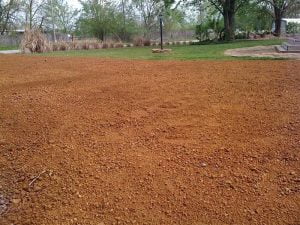Landscape Stone 101: Common Types of Landscape Stone
When it comes to creating walkways, garden pathways, pool areas, or covering ground around flowers and shrubs, you have numerous options . Which landscape pebble to choose for your project mainly depends on two factors: the intended use and your budget. Here is a quick guide of the most common landscaping rocks with their advantages, disadvantages, best uses, and price range.
Decomposed Granite: Natural, Stabilized, Resin-Coated
Decomposed granite lately has become the material of choice for everything from driveways to walkways, outdoor areas, and general landscaping. The main advantage of this material is the price – decomposed granite is very cheap. You can buy decomposed granite in numerous colors. It is also quite durable, particularly when mixed with a binder material. Depending on the intended use, you can purchase decomposed granite in three main forms:
• Natural decomposed granite
This type of decomposed granite is like very, very fine gravel, ground almost to the level of powder. It is water-permeable and will prevent weeds. The main advantages are its cheap price and easy installation. The main disadvantage is the fact that it will wear away over time. It also sticks to shoes and can create a mess if installed close to an entryway.
• Stabilized decomposed granite
This type of decomposed granite (also known as stabilized DG) has stabilizing compounds added, which makes it a lot more durable. Stabilized DG is more expensive than simple natural DG. However, it is well worth the price if you want to use it for driveways or walkways.
• Resin-coated decomposed granite
Resin-coated DG, as the name suggests, is decomposed granite with a resin coating. The result is a compact surface somewhat similar to asphalt. However, unlike asphalt, resin-coated DG is water permeable and generally more “natural.”
Crushed Aggregate / Landscaping Gravel
Crushed aggregate is also called gravel. Although technically they are different materials, most people use the terms interchangeably to refer to the same rugged stones with sharp, irregular edges. The only difference is that only smaller stones are called gravel (sometimes also landscape pebbles). On the other hand, you can purchase crushed aggregate in boulder size as well.
Crushed aggregate is perhaps the oldest and most common type of construction and landscaping stone. You can find it locally in all 50 states as many types of rock can be crushed to create gravel. This includes sandstone, limestone, and basalt. The process is rather simple. First, at stone quarries workers explode large deposits of rock. They then use large machinery to mechanically ground the rock to produce aggregate of various sizes.
The main advantages of crushed aggregate are its extremely low price, local availability, and the option to purchase any size rock from millimeter-sized to boulders. Crushed aggregates are highly versatile and people use them extensively in construction (roads, structures, water systems etc.) as well as landscaping.
The main disadvantage of gravel for landscaping is its rugged surface. With sharp edges and uneven forms, it is difficult to walk on crushed aggregate. And you definitely should not use crushed rocks in any areas where people (or pets) might walk barefoot. Gravel also tends to move around. Furthermore, because of the uneven you cannot use it for many landscape applications.
River Rocks (AZ River Pebbles)
River rocks are a category of stone in between gravel and Mexican beach pebbles. The main type of river rock sold in the United States is Arizona river rock. Various companies mine this stone from the riverbeds of the Salt River and Yuma River in Arizona. They then screen the rock through large commercial screens to separate pieces by size. The color range of Arizona river rock ranges from terracotta to buff, tan, brown, and red.
The main advantage of Arizona river rock for landscaping is that it looks a little bit like beach pebbles but at a much lower cost. AZ river rock is not as smooth as beach pebbles, its texture is more rugged with irregular indentations, and it may have some rough edges. Unlike Mexican landscape pebbles, Arizona river rock does not turn shiny black when wet.
Landscapers mainly use river pebbles as ground cover around plants, shrubs, and trees. Just like Mexican beach pebbles, you can use river rock to suppress weeds, and they similarly last forever.
Mexican Beach Pebbles
Mexican beach pebbles are creme-de-la-creme of landscaping pebbles. Companies source these pebbles at the beaches of Mexico, and workers literally pick them up by hand. The government of Mexico has outlawed any type of machinery at the beaches for two reasons: to protect the vulnerable beach ecosystem and to create jobs at the remote coastal areas. As a result, workers gather beach pebbles one stone at a time.
The main advantage of Mexican beach pebble is the high-end, elegant look. These pebbles are also completely smooth, which means that they are perfect for landscaping around pools and other areas where people (or pets) may walk barefoot. Customers also often use Mexican beach pebbles to create accent pathways, water fountains and decorative ponds, Zen gardens and rooftop gardens. Lately more and more people utilize Mexican beach pebbles for innovative roofing solutions.
Once installed, Mexican beach pebbles last practically forever. Neither hot sun, nor rain, snow or ice will affect them. You can purchase pebbles in numerous sizes from mm-sized to inches to boulders. Colors range from grey (with blue undertones) to buff, tan, ivory, brown, slightly red, and green. The main disadvantage of Mexican beach pebbles is price. As these are high-end landscaping pebbles, they are not feasible for every project. However, buy direct and you can get the best price for your Mexican beach pebbles. Contact us today to get your quote.




